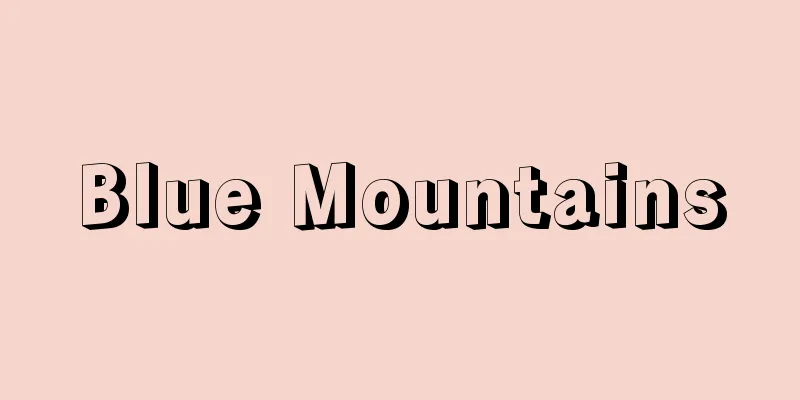Blue Mountains

|
A full-length novel by Ishizaka Yojiro. It was serialized in the Asahi Shimbun newspaper from June to October 1947, and published by Shinchosha in December of the same year. The story revolves around Terasawa Shinko, a female student at a local girls' high school, Kanaya Rokusuke, a high school student, Shimazaki Yukiko, a female teacher, and Numata Tamao, a doctor, and explores in a humorous way the coming democratic lifestyle should be, with themes of the conflict between old and new postwar ideologies such as male-female relationships and the expansion of women's rights. It was received as a breath of fresh air or a textbook on democracy by people in the gloomy and somewhat decadent postwar era. It was made into a film for the first time in 1949, directed by Imai Tadashi and starring Ikebe Ryo (1918-2010) and Sugi Yoko (1928-2019), and drew record numbers of viewers, leaving a strong impression that Ishizaka's literature is about youth. [Eiichi Mori] movieJapanese film. Produced by Toho in 1949 (Showa 24). Directed by Imai Tadashi. Based on a novel by Ishizaka Yojiro that was serialized in the Asahi Shimbun, Fujimoto Sanezumi (1910-1979), who had left Toho, produced it, becoming a huge hit that symbolized the freedom and brightness of the postwar period. In a provincial town, a schoolgirl named Terasawa Shinko (Sugi Yoko) meets Kanaya Rokusuke (Ikebe Ryo), who works at a store in front of the station. When Shimazaki Yukiko (Hara Setsuko), an English teacher, is shown a love letter addressed to Shinko, she consults with the school doctor, Numata (Ryuzaki Ichiro, 1912-1988). Finally, the school board of directors meets to deal with the problem. Yukiko, Numata, and others appeal for freedom of male-female relationships against the feudal school and board of directors, elevating new democratic values. This was the screenwriter Ide Toshiro's (1910-1988) debut work, and all subsequent remakes have been based on this adaptation. It was remade in 1957 by Matsubayashi Shue (1920-2009), in 1963 by Nishikawa Katsumi (1918-2010), in 1975 by Kawasaki Yoshisuke (1936-), and in 1988 by Saito Koichi (1929-2009), and the theme song, with lyrics by Saijo Yaso and music by Hattori Ryoichi, is also well-known. It was released in two parts. It was ranked 2nd in Kinema Junpo's Best Ten. [Shohei Sakajiri] "Blue Mountains" (Shincho Bunko) [References] | | | | |Source: Shogakukan Encyclopedia Nipponica About Encyclopedia Nipponica Information | Legend |
|
石坂洋次郎の長編小説。1947年(昭和22)6~10月『朝日新聞』に連載され、同年12月新潮社より刊行。地方の高等女学校の女学生寺沢新子、高校生金谷六助、女教師島崎雪子、医師沼田玉雄らをめぐって、男女交際、女権拡張など、戦後新旧思想の対立を主題に、きたるべき民主的な生活のあり方をユーモラスに追求した作品。戦後まもなくの、暗く、ややもすれば退廃的になりがちな当時の人々に一服の清涼剤、あるいは民主主義の教科書として受け止められた。1949年今井正(ただし)監督、池部良(いけべりょう)(1918―2010)・杉葉子(すぎようこ)(1928―2019)主演で初めて映画化され、記録的な観客数を動員し、石坂文学=青春物の印象を強烈にした。 [森 英一] 映画日本映画。1949年(昭和24)東宝作品。今井正監督。「朝日新聞」に連載された石坂洋次郎の小説を、東宝から独立した藤本真澄(ふじもとさねずみ)(1910―1979)が製作、戦後の自由と明るさを象徴する大ヒット作になる。ある地方の町、女学生の寺沢新子(杉葉子)は、駅前で店番をしていた金谷六助(池部良)と知り合う。英語教師の島崎雪子(原節子)は新子宛のラブレターを見せられ、校医の沼田(龍崎一郎(りゅうざきいちろう)、1912―1988)に相談する。ついに学校ではこの問題に対処するために理事会が開かれることになる。封建的な学校や理事会に対して、雪子や沼田らが男女交際の自由を訴え、新しい民主主義的な価値観を顕揚する。脚本の井出俊郎(いでとしろう)(1910―1988)は本作がデビュー作、以後の再映画化もこの脚色をもとにしている。1957年に松林宗恵(まつばやししゅうえ)(1920―2009)、1963年に西河克己(にしかわかつみ)(1918―2010)、1975年に河崎義祐(かわさきよしすけ)(1936― )、1988年に斎藤耕一(さいとうこういち)(1929―2009)で再映画化され、西条八十(さいじょうやそ)作詞、服部良一(はっとりりょういち)作曲の主題歌も親しまれている。前後編に分けて公開。キネマ旬報ベスト・テン第2位。 [坂尻昌平] 『『青い山脈』(新潮文庫)』 [参照項目] | | | | |出典 小学館 日本大百科全書(ニッポニカ)日本大百科全書(ニッポニカ)について 情報 | 凡例 |
<<: Blue dragonfly - Blue dragonfly
Recommend
E.K.D.
…The territorial churches have a historical and t...
Office automation equipment industry
...The business machine industry is an industry t...
Western Sahara - Nishisahara (English spelling) Western Sahara
A region in the western tip of Northwest Africa. ...
An Su‐gil (English spelling)
1911‐77 Korean author. Born in Hamhung, South Hamg...
Californiamaru - Californiamaru
…The firefighting efforts on the ship were ultima...
Gilpin, W.
…However, in the second half of the 18th century,...
Platysternon megacephalum (English spelling)
…When a fish approaches, its tongue turns pink an...
radio drama
…A drama-style program broadcast on the radio. In...
Summer purification ritual - Nagoshi no harai
Also known as the Summer Solstice Festival or Mina...
Auscultation
A diagnostic method that uses a stethoscope to lis...
French cuisine - French cuisine
Originally, it was cuisine made by French people ...
Hadano [city] - Hadano
A city in western Kanagawa Prefecture. It was inco...
Enūma eliš (English spelling)
Babylonian creation story. It was dedicated as a r...
Pre-Rembrandtists
…In 1620, he entered Leiden University, but soon ...
Karakurakutsuwa
…The bib with a double-sided mirror plate excavat...





![Takashimizu [town] - Takashimizu](/upload/images/67cc1d23609c5.webp)



